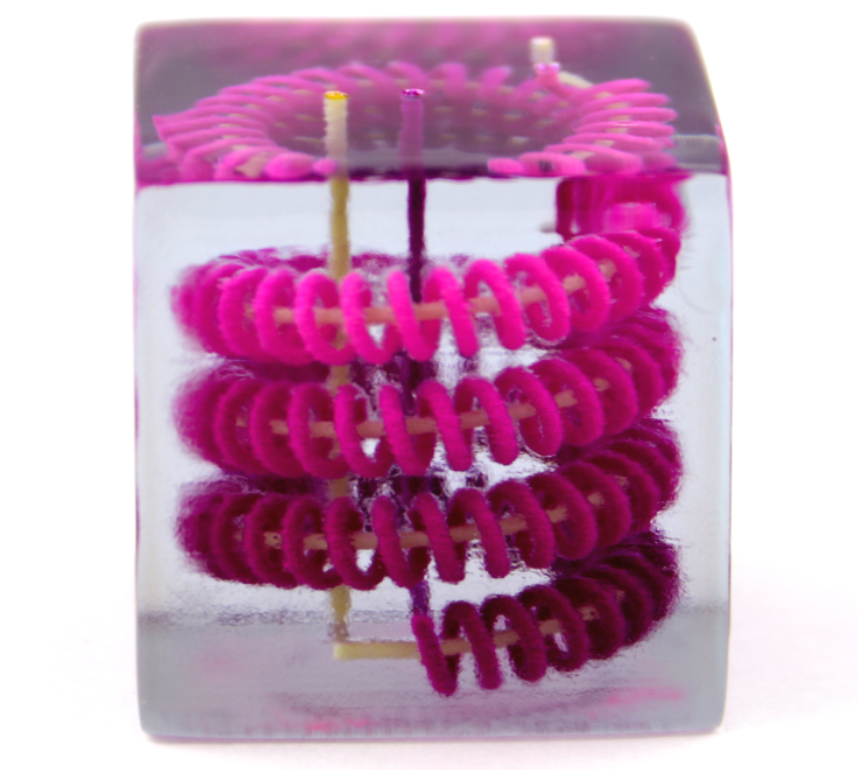Researchers from the University of Colorado Boulder have developed a new method of multi-material 3D printing that’s capable of producing parts with both solid and liquid components.
Virtually all of today’s 3D printers, bar maybe a few experimental devices, 3D print exclusively solid objects. This is great for everything from desk toys and gears to engine parts and electronics casings, but the ability to integrate liquid sections into a build could vastly expand the number of potential applications.
For example, a solid-liquid printer could fabricate entire wearable electronics with solid structural parts and integrated liquid wires, as well as lifelike medical models that more accurately mimic the look and feel of human organs. Taking it a step further, such a machine might even be able to produce an entire print-in-place robot with a single print run, eliminating the need for any assembly.
Robert MacCurdy, senior author of the study, said, “I think there’s a future where we could, for example, fabricate a complete system like a robot using this process.”

A solid-liquid inkjet process
The solid-liquid co-printing approach is based on material jetting, an inkjet 3D printing technique. With conventional inkjet systems, a high-precision printhead is used to jet photocurable resins onto a build platform, hardening the fluid using a UV light to form solid layers.
“Very soon after those droplets are deposited, they are exposed to a bright, ultraviolet light,” MacCurdy adds. “The curable liquids convert into solids within a second or less.”
Traditionally, you’d want the UV light to cure all of the resin that’s been jetted, but selectively preserving some of the material as a liquid can lend itself to clever design features. For instance, a liquid can be used to maintain internal channels within a solid geometry, which can then easily be emptied out later on. Multi-material 3D printers capable of fabricating soluble supports do have this functionality, but it can still be difficult to completely clean out the supports and the internal channels are often limited to simple geometries.
The key is fluid density
Kicking off the project, the Boulder researchers first computationally simulated the physics of printing with several kinds of materials at the same time. They discovered that one of the biggest issues would be in keeping the soon-to-be-solid material droplets from mixing into the liquid material droplets, since the former would have to be jetted directly onto the latter in many cases. The solution: ensuring the liquid material was more dense and viscous than the solid one.
Brandon Hayes, co-author of the study, said, “We found the surface tension of a liquid can be used to support solid material, but it is helpful to pick a liquid material that is denser than the solid material—the same physics that allow oil to float on top of water.”
The team took their findings to the lab and trialed their technique by loading a printer with a curable photopolymer (solid material) and a non-curable cleaning solution (liquid material). They were able to 3D print networks of liquid capillaries in solid matrices, as well as spiraling helix-like liquid patterns. Both of these structures would have been impossible using a conventional solid-only 3D printer.
Looking to the future, MacCurdy envisions the technique being applied to integrated print-in-place multi-material fluidic circuits, electrochemical transistors, lab-on-a-chip devices, and complex robotics.
He concludes, “We hope our results will make multimaterial inkjet 3D printing using liquids and solids more accessible to researchers and enthusiasts around the world.”

Further details of the study can be found in the paper titled ‘Liquid-solid co-printing of multi-material 3D fluidic devices via material jetting’.
Novel 3D printing methods pop up on a rolling basis in the research sphere, enabling new materials, geometries, and applications. Earlier this month, researchers at the University of Freiburg and the University of California, Berkeley came up with a means of rapidly 3D printing complex glass parts at the micro-scale. Known as ‘Microscale Computed Axial Lithography’ (Micro-CAL), this approach involves exposing resin to 2D light images of a desired shape from multiple angles, which when they overlap, trigger polymerization.
Elsewhere, researchers from Stanford University and Harvard University recently developed a new method of volumetric 3D printing capable of fabricating resin parts without the need for any support structures. The approach relies on a nanoparticle-laden resin material that only hardens when it’s blasted with a very focused laser spot.
Subscribe to the 3D Printing Industry newsletter for the latest news in additive manufacturing. You can also stay connected by following us on Twitter, liking us on Facebook, and tuning into the 3D Printing Industry YouTube Channel.
Looking for a career in additive manufacturing? Visit 3D Printing Jobs for a selection of roles in the industry.
Featured image shows a liquid helical spiral 3D printed in a solid block. Photo via CU Boulder.



